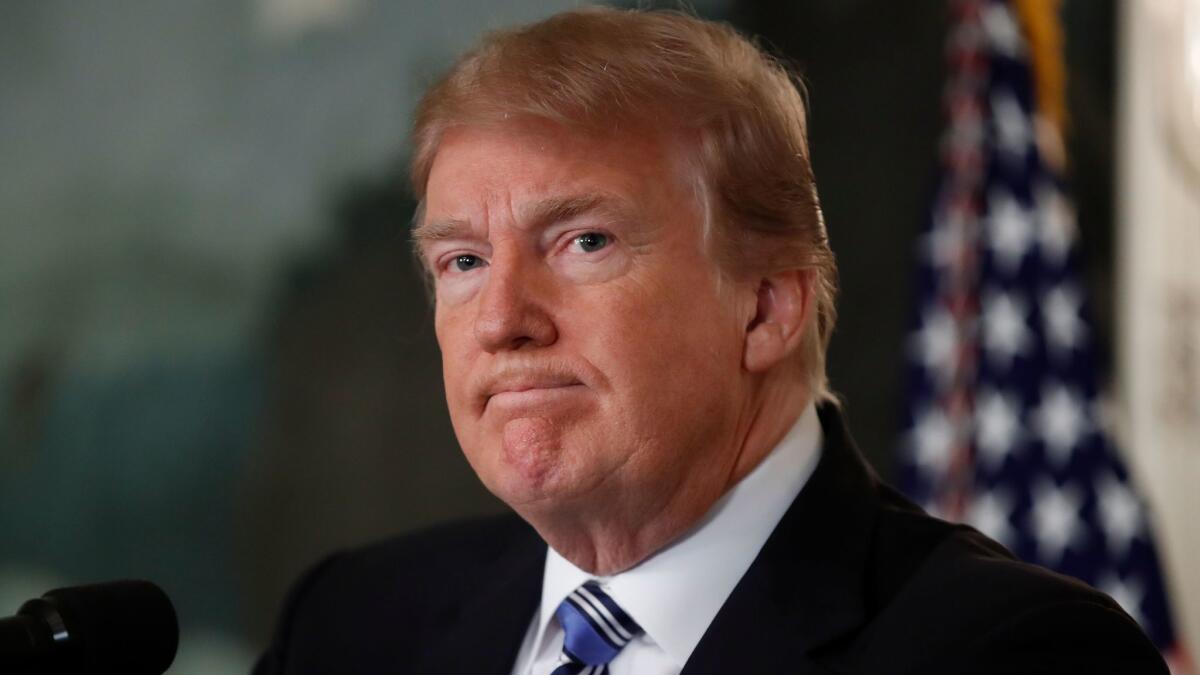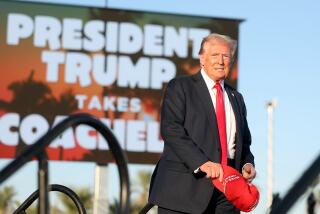After the tragedy in Florida, Trump struggles to show his empathetic side

- Share via
Reporting from Washington — There was a moment in President Trump’s speech Thursday about the deadly school shooting in Parkland, Fla., when his voice seemed to catch for just a moment as he conjured up a picture of parents kissing their children goodbye, sending them off to school for the last time.
“Each person who was stolen from us yesterday had a full life ahead of them,” he said, his voice faltering for a split-second, “a life filled with wondrous beauty and unlimited potential and promise.”
For the record:
5:35 a.m. Feb. 16, 2018This article originally said the White House had canceled a weekend golf trip. In fact, the White House canceled only a Friday trip to Orlando.
Given Trump’s otherwise stoic air, it was unclear whether he was stumbling over the words on his teleprompter or displaying emotion. His shoulders slumped heavily as he walked away from the podium, but that may have reflected the uncomfortable questions about gun control that reporters were shouting at him at the time.
Either way, the moment was notable mainly for its low-key nature, by contrast with Trump’s public response to other crises. His emotions run conspicuously high when he is angry or indignant — which has often been the case with crimes in which the alleged perpetrator comes from another country.
Every new president requires time to ease into the role of helping the nation through joys and sorrows. Whether in triumph or tragedy, the country has a need for displays of sensitivity and strength from its elected leader. No prior role serves as proper preparation, according to those who have watched previous presidents grapple with the challenge.
Trump struggles more than most to display responses other than presidential anger and outrage.
“The country needs the president to lead them through that dark moment,” said Joshua DuBois, a Pentecostal minister who advised President Obama through many crises. “But before we can do that, we need to know the president understands.”
“In a moment like this,” he said, “a president has to be willing to let his heart break.”
That ability has led to memorable moments of presidential leadership in the past: Ronald Reagan promising that Americans would never forget the Challenger astronauts nor the last glimpse of them as they “slipped the surly bonds of Earth to touch the face of God”; President George W. Bush climbing atop the rubble of the Sept. 11 attacks with a bullhorn; President Obama weeping over the death of schoolchildren at Sandy Hook Elementary School and singing ”Amazing Grace” with survivors of a church massacre in Charleston, S.C.
Each of them, however, had rocky early days. Obama came off as aloof. Reagan could be stiff as both of the presidents Bush could be awkward.
Trump, by contrast, often barges in with guns blazing. When an Uzbek man was named as the suspect in the killing of eight people on a New York City bicycle path, Trump fired back with promises of a major crackdown on immigration. Two days after the terror attack in San Bernardino, he threatened a response to terrorists so tough it would get him “in trouble.”
Survivors say that bombastic responses aren’t helpful. They’d rather see the president come to town, pay tribute to victims and offer hope that things will get better.
Obama did that in tragedy after tragedy. Still, it was a piercing wound to some in Oak Creek, Wis., when he failed to visit a Sikh gurdwara immediately after a white supremacist massacred worshipers there. The Obama team’s response was otherwise strong, Sikh activist Valarie Kaur said at the time, but the president failed in the role only the chief executive can play.
“After the attack we endured, Sikh Americans, and all brown and black people in America for that matter, need our president to directly show the nation that we belong here,” she wrote.
Trump’s White House has started to get a stronger feel for how details of the president’s schedule are perceived in the wake of a tragedy. The White House shut down public appearances in the immediate aftermath of the Parkland shooting and canceled a Friday trip to Orlando. Trump’s political operation said he would also cancel a campaign trip to Pennsylvania that would likely have coincided with funerals in Florida.
In putting the president’s Thursday address together, his speech writing team crafted a message of sympathy that focused on the victims and survivors. It hit the same notes as previous presidents in promising federal support for state and local officials dealing with the aftermath.
The address angered some listeners who hoped that the deaths of schoolchildren might inspire Trump to consider changes to the nation’s gun laws. The gunman at Marjory Stoneman Douglas High School mowed down 17 people with a semiautomatic AR-15, the same kind of gun used to kill 20 first-graders at the Sandy Hook Elementary School in 2012. In the six years since that massacre, there have been at least 239 shootings at schools across the country, wounding 438 people and taking the lives of 138.
As little as Trump reveals a softer side to the public, the few times he has done so have involved children. When he declared the opioid crisis to be a public health emergency, he spoke tenderly of the “beautiful, beautiful babies” he wanted to protect. “No child of God should ever suffer such horror,” he said of Syrian children suffering a chemical attack by forces loyal to the country’s leader, Bashar Assad.
“To every parent, teacher and child who is hurting so badly, we are here for you — whatever you need, whatever we can do, to ease your pain,” he said in his remarks Thursday. “We are all joined together as one American family, and your suffering is our burden also.”
Those words were appropriate, said DuBois, but still fell short.
“I do not sense vulnerability from him, and I did not hear real solutions,” he said. “That’s the barrier I believe he’ll have to overcome.”
Twitter: @cparsons
More to Read
Get the L.A. Times Politics newsletter
Deeply reported insights into legislation, politics and policy from Sacramento, Washington and beyond. In your inbox three times per week.
You may occasionally receive promotional content from the Los Angeles Times.











